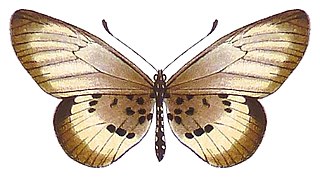
Apamea crenata, known as the clouded-bordered brindle, is a moth in the family Noctuidae. It is distributed throughout the Palearctic realm. In the North it crosses the Arctic Circle, in the Mediterranean it is found only in cool locations and mountains avoiding very hot areas. In the Alps, it rises to an altitude of about 2000 metres.

Colotis fausta, the large salmon Arab, is a small butterfly of the family Pieridae, that is, the yellows and whites, which is found in Israel, Syria, Turkey, Iran, Afghanistan, Turkmenistan, India, Arabia, Chad, Somalia and United Arab Emirates.

Cepora nadina, the lesser gull, is a small to medium-sized butterfly of the family Pieridae, that is, the yellows and whites. The species was first described by Hippolyte Lucas in 1852. It is native to Sri Lanka, India, Myanmar, Hainan, and southeast Asia.

Appias lalage, the spot puffin, is a small butterfly of the family Pieridae, that is, the yellows and whites, which is found in India, Indochina and Hainan.

Appias indra, the plain puffin, is a small butterfly of the family Pieridae, that is, the yellows and whites, which is found in south and southeast Asia.

Junonia hierta, the yellow pansy, is a species of nymphalid butterfly found in the Palaeotropics. It is usually seen in open scrub and grassland habitats.

Rectiostoma xanthobasis is a species of moth in the family Depressariidae. It was described by Philipp Christoph Zeller in 1876. It is found along the Atlantic Coastal Plain from south-eastern Massachusetts south to central Florida and eastern Texas, and north in the Mississippi Valley to Missouri and Illinois.

Acraea lycoa, the lycoa acraea, is a butterfly in the family Nymphalidae which is native to the African tropics and subtropics.

Acraea peneleos, the Peneleos acraea, is a butterfly in the family Nymphalidae, which is native to the tropics and northern subtropics of sub-Saharan Africa.
Prolita princeps is a moth of the family Gelechiidae. It was described by August Busck in 1910. It is found in North America, where it has been recorded from California, Washington, Montana, Oregon, New Mexico, Utah and British Columbia.
Rectiostoma argyrobasis is a moth in the family Depressariidae. It was described by W. Donald Duckworth in 1971. It is found in the humid low highlands of northern Venezuela and south-eastern Brazil.
Rectiostoma chrysabasis is a moth in the family Depressariidae. It was described by W. Donald Duckworth in 1971. It is found in Santa Catarina, Brazil.
Rectiostoma earobasis is a moth in the family Depressariidae. It was described by W. Donald Duckworth in 1971. It is found in Bolivia.
Rectiostoma ochrobasis is a moth in the family Depressariidae. It was described by W. Donald Duckworth in 1971. It is found in the humid low highlands of south-eastern Peru and Bolivia.
Rectiostoma silvibasis is a moth in the family Depressariidae. It was described by W. Donald Duckworth in 1971. It is found in Venezuela.
Rectiostoma thiobasis is a moth in the family Depressariidae. It was described by W. Donald Duckworth in 1971. It is found in Brazil.
Rectiostoma xuthobasis is a moth in the family Depressariidae. It was described by W. Donald Duckworth in 1971. It is found in Colombia.
Rectiostoma callidora is a moth in the family Depressariidae. It was described by Edward Meyrick in 1909. It is found in the humid low highlands of south-eastern Peru and north-western Bolivia.
Rectiostoma eusema is a moth in the family Depressariidae. It was described by Lord Walsingham in 1914. It is found in Guatemala.
Rectiostoma haemitheia is a moth in the family Depressariidae. It was described by Cajetan Felder, Rudolf Felder and Alois Friedrich Rogenhofer in 1875. It is found in the humid low highlands of western Venezuela, central Colombia and Costa Rica. It has also been recorded from Panama and Brazil (Amazonas).








